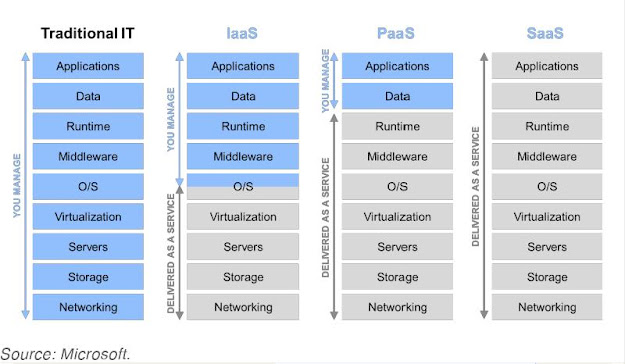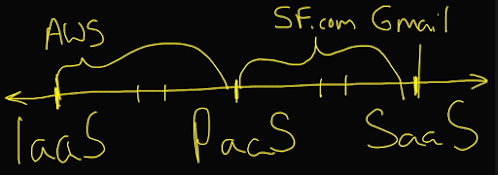What is Cloud Computing?
Microsoft Definition: Cloud Computing is the delivery of computing services - including servers, storage, databases, networking, software, analytics, and intelligence - over the Internet (The cloud) to offer faster innovation, flexible resources, and economies of scale.
Service Models of Cloud
- Cloud, Cloud computing is NOT a buzzword (Unlike Web 2.0 / 3.0, IOT)
- NIST Definition [National institute of standards and technology] - PDF document
The service provider is responsible for the physical h/w required to execute your work and for keeping it up to date. The computing services offered typically include:
Compute power - such as Linux servers or web applications used for computation and processing tasks
Storage - such as files and databases
Networking - such as secure connections between the cloud provider and your company.
Analytics - such as visualizing telemetry and performance data.
IAAS is used in the following scenarios:
- Migrating workloads
- IAAS facilities are managed in a smilar was as on premise infra.
- Provides an easy migration path from on premise to cloud.
- Test and development
- IAAS makes scaling dev and test environments fast and economical.
- Storage, backup and recovery
- aaS is useful for managing unpredictable demand and steadily growing storage needs. IaaS can also simplify the planning and management of backup and recovery systems.
PAAS is used in the following scenarios
- Development framework: PaaS provides a framework that developers can build upon to develop or customize cloud-based applications. Just like Microsoft Excel macro, PaaS lets developers create applications using built-in software components. Cloud features such as scalability, high-availability, and multi-tenant capability are included, reducing the amount of coding that developers must do.
- Analytics and busienss intelligence: PaaS tools allow organizations to analyse and mine their data to find insights and patterns and predict outcomes that will help in business outcomes.
Traditional Models
- Applications - Your applications in the organization
- Data - databases
- Runtime - Java / .NET runtime
- Middleware - Service Bus, EAI, etc.
- O/S - Windows, Linux, Oracle
- Virtualisation - VMWare, etc.
- Servers - physical servers
- Storage - storage disks
- Networking - cables for routing data
IAAS
Blue - You manage
Grey - Things that are delivered by the service provider
Example - MS Azure, and Amazon Web Services (AWS), Rack Space, etc.
- [MS/Amazon manages] When we subscribe to AWS or Azure we get --
- Networking, storage, servers, virtualization, and part of the OS --- Basically, you are going to get the Data Centre + a virtualized machine (e.g. a Windows machine that you can remote-desktop into).
- [You manage] On top of that, you can deploy --
- OS management services like antivirus, backups that you will have to handle yourself.
- Middleware if you need
- Runtime - install java runtime for e.g.
- Data - spin up a virtual machine and install a database on that.
- Deploy your own applications.
- You don't get to play in the service space (Part of OS, virtualization, servers, storage, and networking).
- Amazon calls the above undifferentiated heavy lifting meaning they will do all that stuff for you, and you basically deal with your stuff (that differentiates you from your competitors and in the marketplace) from applications all the way up to OS management services.
PAAS
- Service provider now manages the whole of the OS (patch management, backups, etc.), handling middleware, runtime.
- You will add your applications and data
- Example - AWS managed d/b, managed message queues, managed storage. Azure has a similar lineup. Also SalesForce, which branches out into SAAS as well.
- You only manage say an oracle stack. data schemas, stored procs, etc. + Applications
- Rest is managed by the service provider
SAAS
- The entire stack is managed by the service provider.
- Can do some level of configuration.
- Example Gmail, SalesForce CRM (Also branches out into PAAS)
IAAS-PAAS-SAAS ROI / Cost Efficiency
- SAAS gives a better value for money...
Cloud Computing Characteristics
- On-demand self-service
- Service can be provided as needed automatically without human intervention. Provisioning needs to be automatic; only then it's cloud computing. Automation is the key.
- Broad network access
- Service is provisioned (via an Automated Process) over the network and accessible via mobiles, tablets, desktops - fairly any device over the network.
- Resource pooling
- The service provider has an enormous pool of resources (physical and virtual)
- Serves multiple customers
- Multi-tenanted model
- Different physical and virtual resources dynamically assigned on demand.
- Location-independent (customer has no idea where the infra is)
- Scalable
- Scale-up and down (expand or contract) on demand; provisioned and released automatically
- Vertical scaling: known as scaling up. is the process of adding resources to increase the power of an existing server. e.g. Add more CPUs, adding more memory.
- Horizontal scaling: Known as scaling out. is the process of adding more servers that function together as a single unit. e.g. you have more than one server processing incoming requests.
- Rapid elasticity
- Automatic addition or removal of resources based on demand (spike). e.g. adding more computing resourcse to a spiked website traffic and likewise removing resources when there is a flip. Another example is adding more resources for employees to access an application during work hours.
- Measured service (therefore costeffective)
- Monitored - Users can monitor their spending/utilization thru monitoring (graphs etc.). Once measured, the usage can be controlled.
- Controlled - Users can upscale or downscale the resources based on the monitored, measured service consumption.
- Reported - Reports are generated based on the usage.
- Reliable
- Offers data backup, disaster recovery, data repilcation services, therefore is reliable.
- Redundancy is built up into the service. If one component fails, another takes over.
- Global
- Cloud providers have fully redundant datacenters located in various regions all over the globe. This gives you a local presence close to your customers to give them the best response time possible no matter where in the world they are.
- Secure
- Cloud providers offer a broad set of policies, technologies, controls, and expert technical skills that can provide better security than most organizations can otherwise achieve. The result is strengthened security, which helps to protect data, apps, and infrastructure from potential threats.





No comments:
Post a Comment